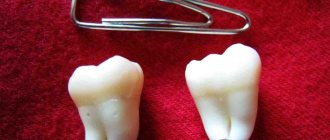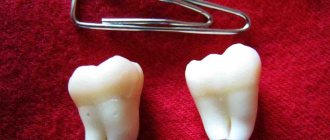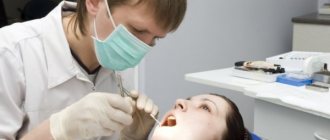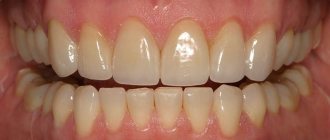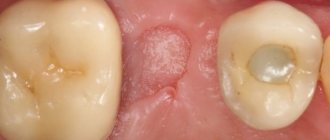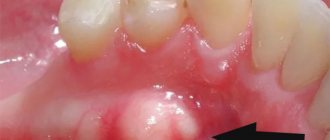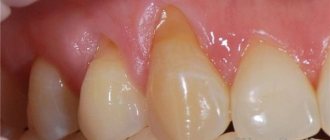What can cause tooth decay?
A tooth is a complex element of our body, the treatment of which takes a lot of time and money. Everyone knows that it is necessary to maintain healthy teeth, however, it happens that at one point a tooth becomes chipped, and this causes great discomfort and looks very unaesthetic, especially when the incisors are damaged. In some people, this is due to the genetically weak condition of the teeth, when they are very susceptible to temperature changes, the gums are sensitive and the enamel itself is fragile. Others are faced with tooth decay as a result of diseases such as caries, increased tooth wear and traumatic periodontitis.
Both enamel (the top layer of the tooth) and dentin (the bottom hard layer of the tooth that hides the pulp and nerve endings) can break off, but there are also cases when the tooth is completely destroyed. Whether it is possible to restore a damaged tooth in one case or another must be determined immediately after the injury. Below in the article you will find criteria for assessing the restoration of a tooth in case of mechanical damage.
Dental restoration: can be done using filling material or installing a prosthesis
When can a tooth be restored?
To find out whether a chipped tooth can be repaired, you need to know the extent of the damage. Of course, if at least some part of the tooth remains in the oral cavity, it will not be difficult to build it up. Specialists will help even if only the root remains. But, before proceeding with restoration, the dentist must make sure that you do not have the following pathologies:
- Bruxism (teeth grinding);
- Inflammatory processes in the oral cavity;
- Bad habits associated with opening bottles, biting threads and chewing hard objects with teeth;
- Diseases of the blood and nervous system;
- Caries;
- Malocclusion;
- Poor oral hygiene;
- Excessive tooth mobility.
In addition to health indications, financial well-being is an important factor, since tooth restoration and restoration cost a lot of money, which can significantly hit your budget.
Dental restoration: the possibility of returning a white-toothed smile directly depends on a person’s financial capabilities
Preventive actions
The most likely causes of chipping are poor oral hygiene, vitamin deficiency and excessive chewing loads. Therefore, prevention of its occurrence is primarily aimed at strengthening bone tissue.
To prevent the development of pathology, it is recommended:
- Stop smoking, since harmful substances, which are contained in large quantities in cigarette smoke, negatively affect the condition of the enamel, weakening it.
- Adhere to a balanced diet and limit the consumption of sweet and hard foods (nuts and candies), as well as carbonated drinks. The diet should consist of fruits and vegetables.
- Strictly observe the rules of personal hygiene. Brush your teeth at least twice a day using a toothpaste enriched with fluoride or calcium. It will help strengthen tooth enamel.
- Use special protective equipment when engaging in active sports.
- Visit the dentist regularly (at least once every 6 months) for a preventive examination.
- Give up bad habits that destroy the tooth surface (biting thread, biting nails).
- Treat concomitant diseases in a timely manner.
Information about what to do if a tooth chips may not be necessary if you follow the rules to prevent such a situation from occurring. It will reduce the risk of caries and other pathologies, and will also preserve its natural color for a long time.
Unfortunately, any even minor damage to the enamel or a small chip of a tooth will sooner or later lead to its destruction. If the pain was a one-time occurrence, it is necessary to restore the damaged tooth in any case. Otherwise, the inflammatory process can cause various complications.
How to restore a tooth with different degrees of damage?
Repairing a chipped front tooth
If a small part of your tooth has broken off, which is more of an aesthetic problem, in this case it is possible to build up the crown using filling material. To do this, you will need to apply anesthesia, apply a rubber dam and build up the broken corner.
Restoring half a tooth
To the question whether it is possible to restore half a tooth, the answer lies on the surface - it is possible. For this, an artificial crown is used; in some cases, the use of pins is also acceptable. There are specialists who may immediately refuse to restore the remaining half of the tooth. Do not despair, perhaps you should find a more qualified specialist, since in the 21st century it is possible to restore a tooth at almost any stage of damage.
Restoring a tooth from 1 wall
If you have one tooth wall left, is it possible to restore it? It’s a simple question. With the help of an artificial crown, you can restore most of the tooth and protect it from further destruction. The use of pins is advisable only if the incisors or fangs are damaged, since the chewing teeth bear a large load and the pins will not be able to cope with it. In addition, a crown is more reliable, especially when less than half of your tooth remains.
Restoring a broken tooth at the root
If a tooth is broken at the root, whether it can be restored depends on the length of the remaining root. It should be enough to install implants. The wall thickness of the remaining root of the broken tooth should be at least 1 mm. In this case, the remaining tooth is first strengthened using a pin or stump tab, and then the question arises of restoring its aesthetic appearance. Once the shape of the tooth is restored, the dentist begins the crown part. The enamel color is selected to best match the color of your teeth, various composite materials are used to create the outer layer, and then the implant is ground for maximum naturalness.
Restoring a completely damaged tooth
Whether it is possible to restore a completely destroyed tooth is an open question at the moment. It all depends on whether at least some part of the root remains, and if it remains, then whether it makes sense to restore it. In this case, the best solution may be not extension, but installation of a prosthesis. Before deciding whether a tooth can be restored or whether it is better to install an artificial one in its place, a thorough examination of the oral cavity and consultation with a highly qualified dentist is necessary.
So, restoring the appearance of a tooth is a complex process, but, thank God, it is quite real. If you have a chipped or broken tooth, do not wait, but seek help immediately to prevent further tooth decay. If all that’s left of the tooth is the root, especially don’t hesitate, high-quality pins or an artificial crown will save your situation, the most important thing is choosing a competent specialist, then your teeth will serve you for many years and decades.
Should I save damaged teeth?
Today the question is not “how to restore a tooth.” Modern dentistry can restore any tooth, even one from which only the root remains. The whole question is the feasibility of such a restoration. The key factors that are important to consider when making this decision are:
Long term assessment.
This is the main thing to consider. As mentioned above, damaged teeth are almost not involved in chewing. In this state they can remain in the mouth for years. If the crown of such a tooth is restored, the chewing load on it will increase significantly! In a loaded state, the lifespan of this tooth will be much shorter! If the tooth canals are sealed poorly, then the increased load will lead to an exacerbation of chronic inflammation and the restored tooth will have to be removed.
The condition of the tissues surrounding the tooth root.
Based on X-ray data, assesses the quality of root canal filling in a damaged tooth. Quite often it is necessary to perform repeated endodontic treatment if you choose to save the tooth. This is due to incomplete filling of the root canals, or to foci of chronic inflammation around the roots of the tooth. The doctor also evaluates tooth mobility. If it is present, then it is not always advisable to save the tooth.
The volume of preserved hard dental tissues.
- If only the root remains of the tooth, destroyed below the gum level, then the tooth is removed.
- If the crown of the tooth is completely destroyed, but the remaining root is motionless and protrudes at least 2-3 mm above the gum, then it must be preserved and included in the prosthetic plan.
It is important to note that these must be healthy hard tissues. Even if part of the crown remains of a tooth, but its entire root is affected by caries, then such a tooth is removed.
It is always the patient’s decision to save the controversial tooth or remove it. The doctor’s task is to assess the actual time frame for the “functioning” of such a tooth if it is restored and explain this clearly to the patient. Each case is individual and only a dentist who has carried out a complete diagnosis can draw up an adequate treatment plan. Trying to resolve this issue over the Internet is useless. The patient’s main task is to understand the potential risk of retaining such “teeth” and make a choice based on the dentist’s recommendations and their capabilities.
Part of the tooth has broken off down to the gum: should it be removed or restored?
Most often, filled teeth from which the pulp has been removed are broken (see also: what to do if teeth break during pregnancy?). Units completely deprived of power become very fragile, which leads to chipping even under light load. However, if this trouble occurs, you should not rush to remove the tooth.
In cases where a tooth has broken below the level of the gum and only the roots remain, or it is so damaged that one wall is visible in its place, a properly carried out restoration procedure will allow the unit to last for many more years (we recommend reading: what to do if a tooth is broken , and its root remained in the gum?). Tissue natural to the body is always better than an implant or bridge.
In the cases described above, doctors resort to prosthetics or extensions, since it is impossible to restore such a tooth with a regular filling. The patient should not hesitate to go to the dentist - the doctor will close the resulting cavity with filling material to protect the remains of the tooth from destruction under the influence of bacteria before the start of the main treatment.
To restore a tooth, certain conditions are required:
- absence of acute diseases;
- correct bite;
- absence of granulomas, cysts, caries, and other oral diseases.
Causes of tooth decay
The reasons are different, ranging from the climate of your place of residence, to personal diseases that can affect the oral cavity and its tissues. Analyzing in more detail the factors influencing destruction, the following stand out most clearly:
The destruction process can be predicted - it consists of several stages:
- Its origin lies in the crown, namely in its yellowing. If you notice yellowing, contact your dentist. In the absence of timely treatment, caries will appear, which can eventually destroy the teeth.
- The next sign will be a softening of the enamel, which is especially acute when eating cold or hot food. If you do not pay attention to softening the enamel in time, over time, places with nerve endings will open, which will cause severe pain.
- The third and main sign is a change in the shape of the tooth, which also indicates its unsatisfactory condition. The shift of teeth can be explained by the fact that hard tissues are not able to hold it in place.
Indications for removal
Before deciding what to do with a broken tooth, the doctor conducts a diagnosis. He talks with the patient, checks the condition of the damaged unit, sends the person for an x-ray to find out if there are tumors or fractures on the roots (for more details, see the article: tooth root fracture: symptoms, causes and treatment). Doctors try by all means to save the tooth, but in some cases it must be removed:
If the tooth is relatively functional, but there is a cyst or granuloma on its root, the doctor can perform amputation of the root or resection of its apex - the unit can be saved and restored. In the case of a severe inflammatory process with the development of periostitis, an abscess or the formation of a large cyst, the element of the dentition will have to be removed.
Recovery from various injuries
The next step will be to become familiar with possible injuries and how to treat them. This article will list several of them:
- slight bruise;
- fracture;
- dislocation.
Minor bruise
Such a bruise is not very dangerous in comparison with other types of injuries and mainly causes only acute pain at the site of impact. One of the unpleasant consequences of such a bruise can be hemorrhage into the pulp.
When you've bruised a tooth, eating can be painful. If there is no hemorrhage, it is enough not to bite anything or touch the sore area, then after a few hours the pain will subside.
In the case of a blood-filled pulp, a visit to the dentist is mandatory because surgical intervention will be necessary. It will consist of cutting tissue and removing pulp, as well as filling all canals.
Fracture
A fracture most often occurs as a result of some kind of mechanical force applied to the teeth. A fracture can also be caused by an impact. The treatment process itself will depend on the damage received. When only a small part of a tooth is broken, it can be easily restored without surgery. In case of serious damage, the dentist will decide on further actions, including removal.
Dislocation
This is a rather serious defect that can be caused by exposure to great force. In the case of strong gums, the chances of luxation are very low. The problem may occur in people with weak gums. In this case, the tooth can easily dislocate even when eating food. There are different types of dislocations and they are all divided into several types, among which I highlight the following:
- isolated;
- fracture of the root part;
- damage to the alveolar process.
Treatment options include:
- pulp amputation;
- filling of diseased canals;
- straightening and further fixation;
- setting the tooth to its initial position.
Restoration methods, pros and cons
Pin + seal
Sometimes caries spreads only deep into the tooth, without affecting its walls, so that the unit can be restored relatively simply and quickly. The tooth is strengthened with a pin and filled. A pin is a miniature rod made of fiberglass or metal that is installed in the dental canal and acts as the base of the filling. The unit is being restored in several stages:
- choose the material for attaching the filling;
- use a special tool to remove tissue surrounding the canal;
- fix the pin with dental cement;
- fill the space between the rod and the walls of the tooth with filling material.
The advantage of this restoration method is speed - the patient can grow a tooth in one visit to the dental office. The pin allows you to restore the functions of a unit that has been destroyed by 50% or more. There will be no pain during the procedure - any operations can be performed on a pulpless tooth. Discomfort may be felt in the gums, but the specialist always offers the patient local anesthesia.
It is worth remembering that a pin and filling are the most unreliable type of restoration. Over time, the patient may experience complications associated with violations of the filling installation technology: it will fall out or secondary caries will gradually develop under the filling material, the walls of the tooth will become thin and begin to crumble. In the worst case scenario, the filled tooth will crack so that it cannot be restored - it will have to be removed.
Core tab + crown
If the crown of a tooth has broken off right up to the gum, it can be restored using a core inlay and an artificial crown. The inlay is made of a composite, metal alloy or zirconium dioxide. This is a one-piece or collapsible structure that is fixed inside the unit. The stump tab differs from the pin in that it is made from individual casts. The installation procedure looks like this:
- The dentist determines whether the tooth will withstand the installation of the structure, after which he processes the root canals and makes impressions of the jaws. The core will be made using a plaster model, and the unit will be covered with a temporary filling and crown during this time.
- On a second visit, the doctor removes the temporary filling, seals the canals, widens and straightens them. An impression of the jaws is taken, from which the technician makes a wax model of the stump. After fitting, an inlay is made.
- During the third visit to the dentist, the tab is inserted into the tooth, secured with cement and pressed firmly until it hardens. A crown is then placed on the restored tooth.
This method of restoration has a number of advantages, because the desired tooth shape is easier to create on a plaster model than in the mouth. Thanks to this, a person can comfortably use the restored unit. The one-piece design is durable, and the uniform distribution of pressure on the surface ensures its long service life.
The disadvantage of this restoration method is the possibility of secondary caries, which will lead to fragility of the tooth walls and loss of the core inlay. In addition, the dead tooth darkens over time, which is why it begins to differ more and more from the color of the prosthesis. Installation of the structure at the dentist will require at least 2-3 visits within a week.
Not every broken tooth can be restored in this way (see also: how can teeth be restored?). Contraindications will be too short or thin walls of the tooth and canals, as well as mobility of the unit.
If a patient has a small part of a tooth chipped off, it can be restored using a veneer. These are thin onlays made of composite or ceramic, made to the shape of a person’s teeth. It is advisable to install veneers on the front and some lateral teeth that are visible when talking or smiling.
If a piece of the unit breaks off, that is, there is a chip, a composite veneer will be installed (ceramic onlays are not used for this purpose). From the front part, a small layer of enamel is ground off on the damaged unit. After this, an impression is taken from it, from which an onlay is made. The veneer is fixed and polished. The entire procedure takes about 2 hours.
Another option is also possible. Photopolymer is applied layer by layer to the turned unit. Then the tooth is also polished and excess volume is removed.
The advantage of this method of restoring elements of the dentition is the ability to accurately match the color of the veneer to the natural shade of the patient’s enamel. The plates last at least 15–20 years and do not change color over time.
A significant disadvantage of veneers is their high price, fragility, and the ability to be installed only on the vestibular surface of the teeth. Before installing the plate, the doctor has to grind down a layer of hard tooth tissue, but without this procedure, the restored unit will look too massive.
What to do if a dead tooth breaks at the root?
“Doctor, I was just chewing a soft bun when I felt something crunch.” This is how the patient’s story usually begins about how it happened that some strange stump was left from the tooth. Is it possible to “save” the tooth from removal in such cases? What criteria does the dentist use in such cases? Finally, how exactly to properly restore a tooth in such situations - fill it with a filling, put a crown, “strengthen it with a pin” or something else? We'll talk about this today.
First, just a little theory. Why do dead teeth break so often ? By creating access to the root canals, the doctor removes quite a lot of tissue. In this case, as a rule, the need for root canal treatment is caused by advanced caries, which by the time of treatment has already “eaten” part of the tooth. As a result of these two reasons, after root canal treatment, the patient receives a severely weakened tooth. Some walls may be completely absent, some will be greatly thinned. Imagine an unopened can of cola... or beer (whichever is closer). Try to break it with your hands. This will not be easy to do. Now open it, drink the contents and you will get a model of the tooth with the insides removed and thin walls. You don’t have to be a beefy bodybuilder to be able to easily crush it with your hands. Much the same thing happens with dead teeth. Fragile walls cannot withstand large and constantly repeated cyclic loads during chewing. Our masticatory muscles can develop a force of up to 400 kg cm2. Imagine that such a 400-kilogram young man is riding on your tooth every day.
At the same time, it doesn’t matter at all what you eat: crackers, nuts or fresh bread. Sooner or later, the weakened walls of the tooth will crack. And this result is inevitable.
What to do if a tooth is broken? Should I delete it? Or can it be restored? And, if possible, how to do it better? The main criterion by which the doctor decides on the advisability of preserving the “hemp” is the quantity and quality of hard tissues rising above the gum. Ideally, it should be like this: the edges of the tooth along the entire perimeter are above the level of the gum, the height of the walls is at least 2-3 mm, the thickness is at least 1-2 mm.
Moreover, the higher and thicker the walls, the better the prognosis for restoration. If the tooth wall is chipped deep under the gum, then such teeth often have to be removed. Because no design with a good prognosis can be made for such teeth. If we neglect this rule, then in the very foreseeable future we will get something like this...
...the crown is in the hands, not in the mouth. Any filling, crown, whatever... will not last long on such a root. The main reason for this is that somewhere down there, in the depths of the gums, it is impossible to achieve a perfect fit of any material to the tooth. Any restoration, if done anyway, will begin to “leak” quite quickly under such conditions. This means that the infection living in the oral cavity will easily penetrate into the tooth, “undermining” the tooth from the inside. Therefore, it will be much more reliable to replace such a root with an implant. Of course, you can always find a compassionate dentist-plasterer who will stick something on, apply some grease and at the same time sleep peacefully. But if we are talking about quality and durability, then such options are not for us.
What then for us? Here are some possible correct options for restoring severely damaged dead teeth.
Restoring the tooth stump with a filling + crown.
For example, as in this clinical case. In such cases, a special composite material or amalgam is used to recreate the base of the tooth*
Restoration of the tooth stump with a filling on a fiberglass pin + crown.
Everything is the same, but the filling material is “strengthened” with a pin. This is usually done when there is very little tooth tissue and there is no particular hope for them.
There are many opinions on the advisability of “pinning” teeth, and even among dentists there is no unity on this topic. Some people put pins in all their teeth in a row, others don’t do them at all. The truth, as always, is somewhere in the middle. One thing is for sure - the use of the so-called. anchor metal pins (similar to small screws) today are bad manners.
Stump tab + crown.
In this case, the base for the crown is made in a dental laboratory and is a monolithic structure glued inside the canal. Stump inlays today can be made of metals (cobalt-chromium and gold-platinum alloys) or zirconium dioxide.
These are the main methods for restoring a tooth if it is broken. Each dentist makes the choice between them at his own discretion. The only thing you need to remember: any technique that involves installing a pin in the root canal requires their ideal treatment, because there will be no repeat relatively easy access to them. Therefore, any treatment with pins is in fact the last for the tooth, after which most often only removal is possible. For this and some other reasons, today there is a tendency to move away from the manufacture of any pin structures, especially stump inlays.
So now you know how and what is the best way to restore broken dead teeth.
Rules for caring for a restored tooth
Whatever method is used for restoration, you need to remember that this is an artificial structure, not a natural tooth (see also: dental restoration: photos before and after this procedure). The product requires careful use, but this does not mean that you need to eat only purees and cereals - the doctor made the tooth in order to restore the patient’s chewing function. However, a person should refrain from eating nuts, seeds, and chewing other hard foods.
You need to carefully care for your restored teeth. The patient must adhere to the following hygiene rules:
- brush your teeth twice a day;
- use interdental brushes, mouthwash, and dental floss;
- try not to put excessive pressure on the repaired unit;
- reduce consumption of carbohydrate foods;
- conduct an independent examination of the oral cavity looking for changes (the appearance of cracks, inflammation, darkening, etc.);
- Visit the dentist twice a year for a preventive examination.
Reasons why teeth become loose
It’s normal for a child’s baby teeth to become loose: they make room for the molars. But why does a healthy tooth become loose in an adult who has never had any special dental problems? This can happen for several reasons.
- Poor oral hygiene.
The most common reason why teeth become loose. Bacterial plaque that is not completely cleaned quickly mineralizes, turning into hard tartar. Bacteria actively multiply in it, causing inflammation of the gums - gingivitis. - Periodontitis.
According to the World Health Organization, 98% of people over the age of 40 experience inflammatory processes in the musculoskeletal system of the teeth. With poor oral hygiene, tartar, increasing in volume, gradually separates the gums from the surface of the teeth, and the infection penetrates into the periodontal tissues that hold the tooth in the jaw bone. Bacteria destroy the ligaments of the tooth, and it loses its support. - Periodontal disease.
This pathology is characterized by atrophy of the ligamentous apparatus of the tooth due to systemic disorders in the body. The process takes place without inflammation, and the main symptom is exposure of the root region (the teeth “come out” of the gums). - Dental diseases.
These are mainly pathologies that affect the peri-root area: periodontitis, cysts, granulomas. They can also destroy the ligaments between the teeth and jawbone. - Bite pathologies.
Improper closure of the teeth leads to excessive pressure on the dental ligaments, which gradually destroys them. This reason why teeth become loose is similar to another - bruxism, the involuntary clenching of teeth during sleep. - Systemic disorders.
Diabetes mellitus, thyroid diseases, and cardiovascular pathologies can negatively affect the blood supply to the periodontium. Gums are also weakened by hypovitaminosis, poor nutrition, and hormonal changes. For example, women during pregnancy may find that their teeth are a little loose. - Bad habits.
Smoking and alcohol abuse also impair blood circulation in the gums.
What can be done if the wall of a tooth breaks off?
At the moment I am in China, there are difficulties due to the language barrier. The trouble is this: the wall of the chewing tooth has broken. The dentist took a picture and, as I understand it, they said that they couldn’t do it.
Can you suggest what can be done?
This tooth is removed if the cause is interradicular inflammation. This inflammation cannot be treated.
Comments and reviews 32
All I have left of my tooth is a wall and a hole. The wall of the tooth began to wobble. Is it better to have a tooth pulled out or augmented? Answer
A targeted x-ray of this tooth is required. Most likely, if one wall of the tooth remains and is still mobile, then the tooth must be removed. But we can say more accurately after inspection. Consult a prosthodontist. Answer
Dental surgeon-implantologist, C.M.N. Work experience 15 years.
A filling fell out of my tooth. The tooth is without a nerve because it was removed. In addition to the filling, some walls of the tooth fell off. Is it necessary to remove a tooth? And if we do remove it, will it hurt or not? Answer
The need for tooth extraction can be assessed using an x-ray. You need to take a targeted x-ray and contact a dentist. If the roots of the tooth are treated well, there is no inflammation in the area of the root apex and the root itself is intact, then orthopedic restoration of the tooth is possible (pin + inlay, pin + crown). Of course, if the root is in poor condition, the tooth will be removed. There is no need to be afraid, modern anesthetics are very powerful and with proper anesthesia, patients do not feel anything. Answer
Dental surgeon-implantologist, C.M.N. Work experience 15 years.
Today the wall of my upper chewing tooth broke off, which causes great discomfort. How to treat a tooth in such a case? Answer
An examination and a targeted x-ray of the tooth is necessary. 1) As a rule, the tooth wall chips when the chewing tooth was previously treated and restored with a large filling. And when chewing, the thin wall cannot withstand the load and breaks off. 2) If the chip occurs below the gum level, this is an indication for tooth extraction and restoration of the defect with an implant or bridge. If it is above the gum level, then endodontic treatment of the tooth and its restoration with an inlay and a crown. Consult in person with a dental therapist. Answer
Dental surgeon-implantologist, C.M.N. Work experience 15 years.
Features of restoration of the roots of the frontal group of teeth destroyed below the gum level
The so-called all-ceramic designs of dentures (manufactured in various ways: slip casting, injection molding, layer-by-layer application of ceramic mass on a fire-resistant model, etc.) have become firmly established in practice, and today it is difficult to imagine a full range of work in orthopedic dentistry without them. The use of such structures has created new requirements for the tooth stump on which such a crown will be fixed (the minimum thickness of the crown should be 2.5 mm, requirements for transparency and polishing of the shoulder part of the stump). Some difficulties are presented by clinical cases when the tooth stump needs to be restored after a root fracture located just below the gum level. But even in such cases, adequate restoration of the destroyed tooth stump is possible. The main difficulty will be the requirements for surface drying when working with composite materials and dentin bonding agents used for core restoration, since drying the root surface located below the gum level is quite problematic. It is necessary to work with the obligatory use of a cofferdam and try to restore the initially destroyed wall at least to the level of the gum. You can then safely proceed with the adhesive fixation of the fiberglass pin in the root canal, since the transparency requirements complicate the use of metal pin structures for restoration. Using a clinical case, I would like to demonstrate a similar situation. A 22-year-old patient came to our clinic with a fracture of the crown of tooth 21 located below the gum level (Fig. 1).
rice. 1. Patient M., 22 years old, fracture of the crown of tooth 21 located below the level of the marginal gum.
At the same time, it was necessary to create the most “live”, natural work. We chose the treatment option using an all-ceramic crown. To do this, it was necessary to restore the destroyed tooth stump using materials close to the natural transparency of the tooth. For restoration, a composite material and a fiberglass pin were used, fixed in the canal using dual-curing cement (Fig. 3,4,5).
rice. 3. Using a cofferdam and contoured matrix strips, we restore the destroyed wall to the level of the gum.
rice. 4. We restore the cervical area of the stump while simultaneously preparing the canal for adhesive fixation of the pin.
rice. 5. The fiberglass pin is fixed.
Previously, endodontic treatment was carried out using the Thermafil system, as well as correction of the gingival margin on the medial side (Fig. 2).
rice. 2. Endodontic treatment of tooth 21 using the thermophil system.
The final preparation of the stump and especially its inferior part was carried out using carbide burs. We chose these burs due to a number of competitive advantages. Firstly, the sufficiently large length of the working surface of the bur allows processing the tooth stump to its entire height, which significantly facilitates the task performed (Fig. 6.).
rice. 6. A sufficiently large length of the working surface of the bur allows processing the tooth stump to its full height.
Secondly, carbide burs have horizontal notches located in a certain way on the working blades of the bur, which significantly speeds up the process of removing large volumes of hard tissue. Thirdly, the end of the bur head is increased in size and has a fairly large radius of curvature, with a complete absence of horizontal notches on the end of the bur head (Fig. 7.).
rice. 7. The end of the bur head is increased in size and has a fairly large radius of curvature, with a complete absence of horizontal notches on the end of the bur head.
This design of the bur makes it simply an ideal tool for forming the final ledge on the tooth stump and, at the same time, for finishing the ledge to a glossy surface. (Fig. 8.9.)
rice. 8. The formed ledge on the tooth stump is clearly visible.
Fig. 9. The ledge on the stump of the prepared tooth is polished to a glossy surface.
Using carbide burs, we can easily create a rational, semicircular ledge for a future all-ceramic crown. Subsequently, we only correct it with a bur that has a larger radius of curvature of the head, which allows us to level the surface of the ledge, removing sharp edges and elevations at the border of the ledge and the gums. It should be noted that the production of such work requires very careful preparation with a good centered tool. Since only a perfectly formed stump, without undercuts, will enable the technician to create a crown that fits exactly to the stump. Otherwise, there is a danger of the ceramic structure splitting due to microstresses arising in the ceramic during function, due to uneven contact with the stump. We carried out the taking of a double refined impression and the direct production of a provisional crown according to the generally accepted method. We carried out the final fixation of the finished artificial crown using dual-curing composite cement, since only this group of materials is capable of forming a chemical bond with both the tooth stump and the crown. In addition, these materials are quite strong, plastic and fluid, and also have a fairly wide range of colors and gradations of transparency, which ensures natural color rendition and transparency of the artificial crown (Fig. 10).
Fig. 10. Finished work in the oral cavity.
“You have to fight for your tooth until the last moment.” Expert on the latest treatments
Valery Leontyev, academician of the Russian Academy of Sciences, vice-president of the Dental Association, director of the professorial dental clinic tells .
Valery Leontyev: Even if the doctor suggests pulling out a tooth, do not rush. After removal, the bone that held the tooth remains without load. This leads to its resorption and atrophy, which can have a detrimental effect on both the oval of the face and the condition of neighboring teeth. You need to fight to the last - fortunately, today there are techniques that allow you not only to save a seemingly hopeless tooth, but also to use it as a support for crowns and bridges. Moreover, even large molars, which usually fail first and are therefore removed at a young age, can have a favorable prognosis. These teeth have a large area and several roots. Even if one root is damaged, it can either be sterilized (using new antiseptics), or, by removing it, the remaining roots can be saved.
Lydia Yudina, AiF: Cysts and granulomas are often found on the roots of teeth - in such cases, doctors scare with an abscess (abscess) and suggest not to hesitate.
— Cysts (a hollow formation similar to a tumor) and granulomas (small cysts) are really very insidious. They become inflamed under stress, hypothermia, etc., and dissolve bone tissue. In addition, it is a source of infection in the body, which can provoke the development of toxic processes and even cause heart and joint diseases. But to remove a cyst or granuloma, it is not necessary to remove a tooth. It is enough to either treat the canal or remove the tumor along with part of the tooth.
— If a tooth has already been destroyed to the ground, how can it be restored?
— In such cases, a pin is installed in the root, on which a crown is placed or a natural one is built up using a composite material. For less significant damage, an inlay is made. A tooth is considered hopelessly lost if there is no longer either the tooth itself or a treatable root left.
— Inlays and crowns are made of durable materials. Why do they have such a short service life - no more than 10 years?
— Metal, porcelain, and ceramics can last up to 100 years. The problem is in the remaining part of the tooth, which continues to decay under the influence of microflora. An inaccurately fitted tab promises the same troubles. The first signal of trouble is an unpleasant odor or blood from under the crown. You need to care for artificial teeth more carefully than your natural teeth. Proper care increases the service life to 15-20 years.
— Many doctors believe that installing implants is Russian roulette. They are rejected even in cases where preliminary tests for survival have given the go-ahead.
— No one can give a 100% guarantee that the body will accept the implant. In my opinion, the point is not so much in the body’s reaction to the implant, but in the skill of the doctor. I know dentists whose rejection rate does not exceed 2-3%. In addition, implantology is actively developing and in the future may become one of the main methods of rehabilitation and treatment.
— Isn’t it more reliable to use old technology - installing bridges?
— Modern methods of tooth replacement are quite reliable and have approximately the same service life. But every doctor has his own method, which he knows best. Therefore, it is better to use the method that your doctor advises you. A well-made and correctly installed bridge will last longer than an implant if the doctor rarely works with it.
Materials for crowns and inlays
This is largely a matter of price and the doctor’s skills. In terms of strength and durability, the materials practically do not differ from each other. The differences are mainly aesthetic.
- Gold – gold crowns and inlays are strictly recommended for patients with gastrointestinal diseases. This is the most biocompatible material with the body.
- Metal - made for teeth that are not visible in a smile.
- Porcelain has physical properties similar to tooth enamel, does not cause allergies, does not change color, and does not absorb moisture.
- Ceramics - does not cause allergic reactions, does not change color, is translucent, and completely imitates the color of a tooth.
The wall of the tooth broke off to the level of the gum
Good evening. This is the situation. On the upper gum, the outer wall (which rubs against the cheek) of the 5th tooth on the right side has broken off. I counted from the middle of my teeth. Due to the fact that I was out of town, I went to the dentist 2 days later. During the examination, the doctor said that this wall needed to be removed. The outer wall was removed. This is what we did as a temporary solution. They left the inner wall and, with the composition used to put fillings, the tooth was restored. That is, now it looks like a natural tooth, but the inner wall is my own, the distance between the inner and outer walls, and the outer wall itself is the composition that is used for fillings. I did it with a doctor I know, she said that everything is ok, go ahead and come closer to N.G. and we’ll see. Here Ps the composition was heated for me, or dried with ultraviolet light. (that is, the “filling” is good, not just cement..)
Is it possible to walk like this, or is it better to get a crown soon, or something else? Please advise.
One wall of the tooth remains
After the damage, only one wall remains? This situation is not particularly critical, just like if a small part of your tooth breaks off. In such cases, you can restore the health of your gums and teeth with the help of:
- using a crown;
- full extension using pins.
In the option with extensions, you will have to pay for the pins and material, so the price will depend on the material. What's good about this method? After extension, the tooth will look like its own and have an ideal shape, the nerve canals and the tooth root will be protected from external factors. Using high quality materials, this design will never break off.
